Innovation Management
"Agile Scrum: Your Quick Start Guide with Step-by-Step Instructions" by Scott M. Graffius Quoted by Informa Middle East
14 December 2018
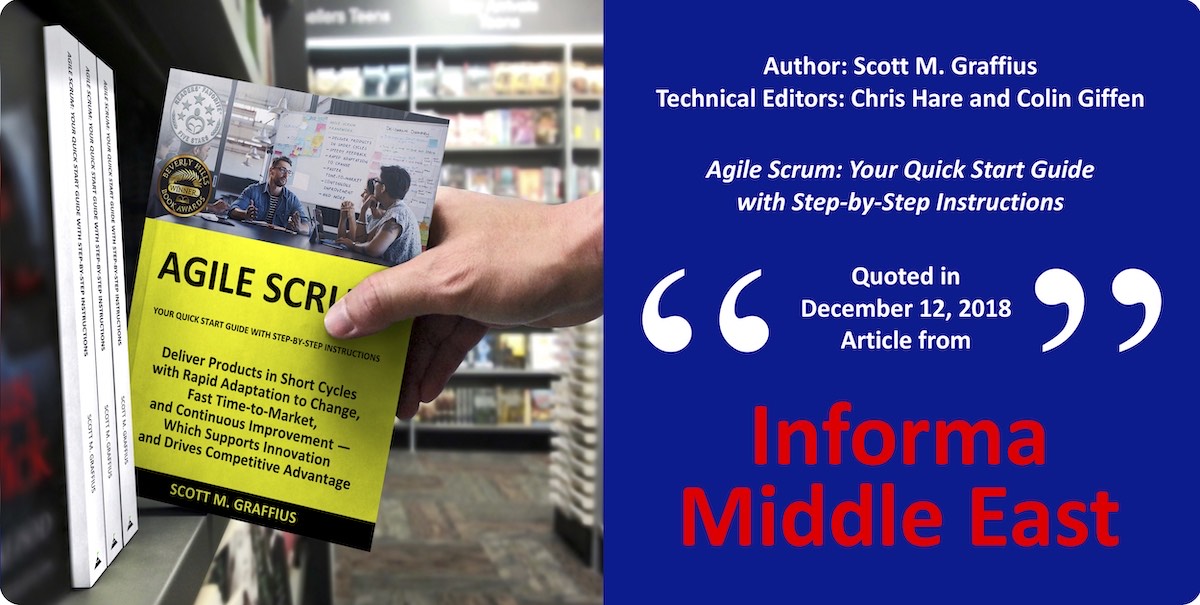
Scott M. Graffius, CEO of Exceptional PPM and PMO Solutions™, had consulting engagements with a division of a global entertainment business. A fantastic agile transformation experience and result with that client was the inspiration for Scott's book, Agile Scrum: Your Quick Start Guide with Step-by-Step Instructions. This is an update related to the book.
Content from Agile Scrum (Scott M. Graffius, author; Chris Hare and Colin Giffen, technical editors) is quoted in a piece by Informa Middle East. Informa is a leading Dubai-based company offering business intelligence, academic publishing, and services in event management.
A red arrow in the accompanying image (a higher resolution version is available here) points out the quote. You can read the Informa article by Anishka Abraham—which includes what to do and avoid with metrics—here: https://www.informa-mea.com/blog/7-mistakes-to-avoid-when-measuring-innovation/.
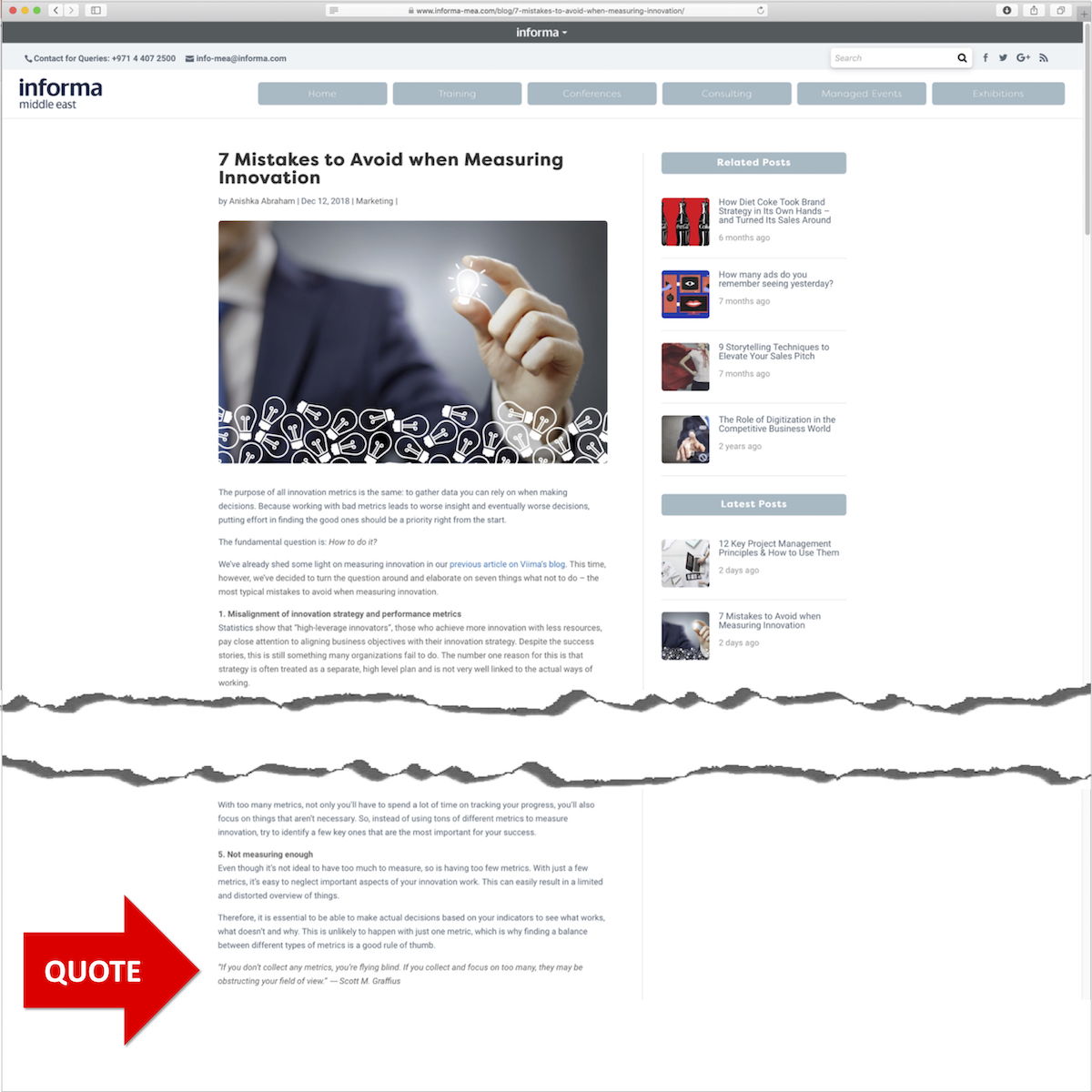

About Scott M. Graffius

Scott M. Graffius, CSP, CSM, CSPO, PMP, ITIL, LSSGB is a project management expert, consultant, international speaker, and award-winning author. He is the CEO of Exceptional PPM and PMO Solutions, a professional services firm, where he partners with client companies to help them achieve their strategic objectives and business initiatives through project management leadership. The consultancy provides project, program, portfolio, and PMO management services inclusive of agile, traditional, and hybrid development and delivery frameworks. Business results include upgraded responsiveness to business needs, faster delivery and time-to-market, improved on-budget performance, higher customer and stakeholder satisfaction, and greater competitive advantage. Scott is a former vice president of project management with a publicly traded provider of diverse consumer products and services over the Internet. Before that, he ran and supervised the delivery of projects and programs in public and private organizations with businesses ranging from e-commerce to advanced technology products and services, retail, manufacturing, entertainment, and more. He has experience with consumer, business, reseller, government, and international markets. Additional information is available at: http://Exceptional-PMO.com/who_we_are/bio.

About Agile Scrum: Your Quick Start Guide with Step-by-Step Instructions

A fantastic agile transformation experience and result with a client organization in the entertainment industry was the inspiration for Scott M. Graffius’s multi award-winning book, Agile Scrum: Your Quick Start Guide with Step-by-Step Instructions (ISBN-13: 978-1533370242).
Here's an excerpt from the book: "Shifting customer needs are common in today's marketplace. Businesses must be adaptive and responsive to change while delivering an exceptional customer experience to be competitive. Traditional development and delivery frameworks such as waterfall are often ineffective. In contrast, Scrum is a value-driven agile approach which incorporates adjustments based on regular and repeated customer and stakeholder feedback. And Scrum’s built-in rapid response to change leads to substantial benefits such as fast time-to-market, higher satisfaction, and continuous improvement—which supports innovation and drives competitive advantage."
With clear and easy to follow instructions, Agile Scrum: Your Quick Start Guide with Step-by-Step Instructions helps you:
- Implement and use the most popular agile framework―Scrum;
- Deliver products in short cycles with rapid adaptation to change, fast time-to-market, and continuous improvement; and
- Support innovation and drive competitive advantage.
Hailed by Literary Titan as “the book highlights the versatility of Scrum beautifully.”
Winner of 17 first place awards.
Agile Scrum: Your Quick Start Guide with Step-by-Step Instructions is available in paperback and ebook/Kindle in the United States and around the world. Some links by country follow. Get your copy today!
- 🇦🇺 Australia
- 🇦🇹 Austria
- 🇧🇪 Belgium
- 🇧🇷 Brazil
- 🇨🇦 Canada
- 🇨🇿 Czech Republic
- 🇩🇰 Denmark
- 🇫🇮 Finland
- 🇫🇷 France
- 🇩🇪 Germany
- 🇬🇷 Greece
- 🇭🇺 Hungary
- 🇮🇳 India
- 🇮🇪 Ireland
- 🇮🇱 Israel
- 🇮🇹 Italy
- 🇯🇵 Japan
- 🇱🇺 Luxembourg
- 🇲🇽 Mexico
- 🇳🇱 Netherlands
- 🇳🇿 New Zealand
- 🇳🇴 Norway
- 🇪🇸 Spain
- 🇸🇪 Sweden
- 🇨🇭 Switzerland
- 🇦🇪 UAE
- 🇬🇧 United Kingdom
- 🇺🇸 United States
- 🌏 More countries

Let's Connect
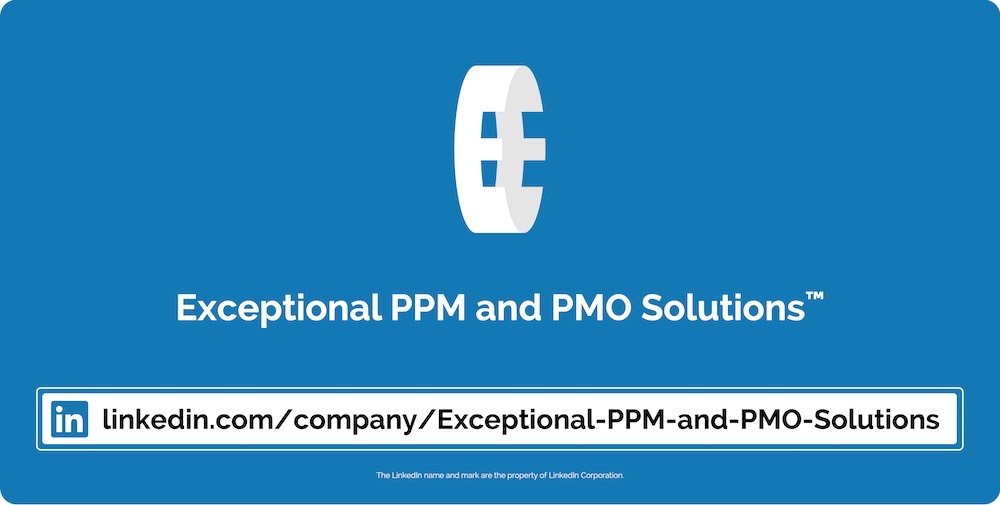
Connect with us on LinkedIn, Twitter, and Facebook.

© Copyright 2018 Scott M. Graffius, Exceptional PPM and PMO Solutions™. All rights reserved. This material may not be published, broadcast, rewritten or redistributed without the express written permission of Scott M. Graffius/Exceptional PPM and PMO Solutions™.

The Inspiration for the Book on Agile Project Management, “Agile Scrum: Your Quick Start Guide with Step-by-Step Instructions” | Part 1
08 March 2019
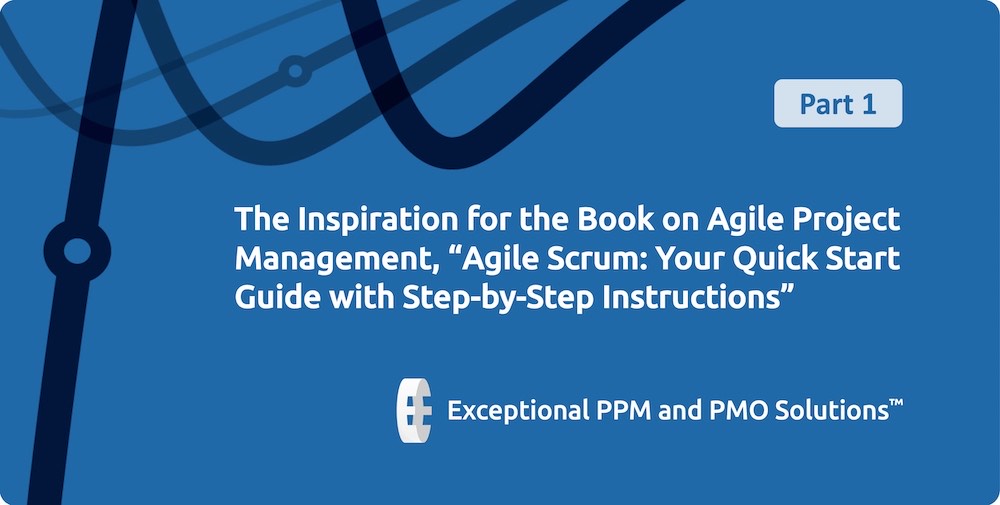
The Inspiration for the Book on Agile Project Management, Agile Scrum: Your Quick Start Guide with Step-by-Step Instructions
Scott M. Graffius, CEO of Exceptional PPM and PMO Solutions™, helps companies achieve their strategic objectives and business initiatives through project management leadership. A fantastic agile transformation outcome with a client organization in the entertainment industry was the inspiration for Scott's award-winning book, Agile Scrum: Your Quick Start Guide with Step-by-Step Instructions. This is the story behind the book—told by Scott. Identifying details have been changed and certain elements are not included.
This article is the first installment of the eight-part story.

Agile Transformation at an Entertainment Company | Part 1: The Call
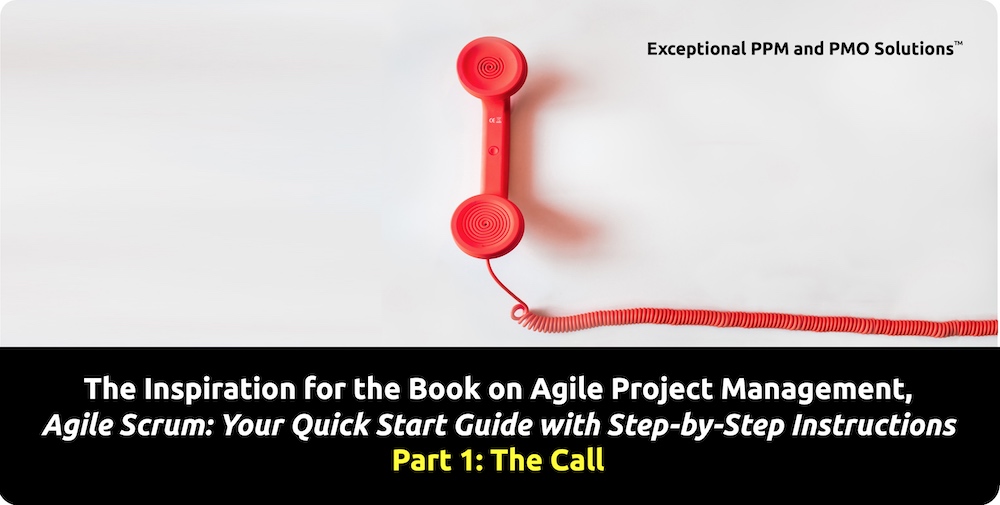
The assistant to the executive vice president (EVP) of technology for a division of a global entertainment company contacted me by phone. I was told that I was referred by someone who knew me and thought I would be a good fit for contract work. A one-hour consultation with the EVP was scheduled for the next day. I then received an email with several attachments including a non-disclosure agreement which needed to be executed and brought to the meeting.
I brought the documents to the session. The EVP explained that his division of the company was experiencing an alarming trend of problems with project management. He reported that deliverables were not meeting expectations, there was a marked decline in satisfaction, and—this was characterized as "the straw that broke the camel's back"—a highly skilled and very well-respected team member quit, citing the problems as her reason for departure.
After an hour with the EVP, we agreed to extend the meeting (initially, my complimentary consult) an additional hour (billable time). I learned that this division of the company previously used a traditional plan-driven/waterfall approach for development and delivery. The EVP explained that things worked reasonably well then and that they were "close enough" to being on-scope, on-budget, and on-time that team members and stakeholders were satisfied.
The EVP explained, however, that he wanted to adopt a model (Scrum) employed by some of the other divisions of the company. The EVP said that he conducted a search for a value-added reseller (VAR) to help his group move to agile. A VAR-partner of a popular software solution was selected, and the VAR transitioned the group to Scrum. Reportedly, very few problems surfaced during the VAR's contractual engagement, which ended two weeks into the first sprint (then, the duration for sprints was four weeks). Many problems surfaced subsequently, however. The VAR had been gone for two months at the time of my meeting with the EVP.
The EVP asked me to make things right. I explained that change depends on many people and multiple factors and that a specific end result could not be guaranteed. I suggested, however, that I'd be honored to work with his group in the first step—an assessment—which would help inform the subsequent work of foundational planning. The objectives of the assessment include working closely with the EVP, the Scrum Team and stakeholders to understand their goals—and the environment, roles and practices. He asked me when I could start. I asked him when he needed me, and he replied "immediately." I agreed to start the next day.
The Inspiration for the Book on Agile Project Management, Agile Scrum: Your Quick Start Guide with Step-by-Step Instructions continues with Part 2: The Goals.

About Agile Scrum: Your Quick Start Guide with Step-by-Step Instructions

A fantastic agile transformation experience and result with a client organization in the entertainment industry was the inspiration for Scott M. Graffius’s multi award-winning book, Agile Scrum: Your Quick Start Guide with Step-by-Step Instructions (ISBN-13: 978-1533370242).
Here's an excerpt from the book: "Shifting customer needs are common in today's marketplace. Businesses must be adaptive and responsive to change while delivering an exceptional customer experience to be competitive. Traditional development and delivery frameworks such as waterfall are often ineffective. In contrast, Scrum is a value-driven agile approach which incorporates adjustments based on regular and repeated customer and stakeholder feedback. And Scrum’s built-in rapid response to change leads to substantial benefits such as fast time-to-market, higher satisfaction, and continuous improvement—which supports innovation and drives competitive advantage."
With clear and easy to follow instructions, Agile Scrum: Your Quick Start Guide with Step-by-Step Instructions helps you:
- Implement and use the most popular agile framework―Scrum;
- Deliver products in short cycles with rapid adaptation to change, fast time-to-market, and continuous improvement; and
- Support innovation and drive competitive advantage.
Hailed by Literary Titan as “the book highlights the versatility of Scrum beautifully.”
Winner of 17 first place awards.
Agile Scrum: Your Quick Start Guide with Step-by-Step Instructions is available in paperback and ebook/Kindle in the United States and around the world. Some links by country follow. Get your copy today!
- 🇦🇺 Australia
- 🇦🇹 Austria
- 🇧🇪 Belgium
- 🇧🇷 Brazil
- 🇨🇦 Canada
- 🇨🇿 Czech Republic
- 🇩🇰 Denmark
- 🇫🇮 Finland
- 🇫🇷 France
- 🇩🇪 Germany
- 🇬🇷 Greece
- 🇭🇺 Hungary
- 🇮🇳 India
- 🇮🇪 Ireland
- 🇮🇱 Israel
- 🇮🇹 Italy
- 🇯🇵 Japan
- 🇱🇺 Luxembourg
- 🇲🇽 Mexico
- 🇳🇱 Netherlands
- 🇳🇿 New Zealand
- 🇳🇴 Norway
- 🇪🇸 Spain
- 🇸🇪 Sweden
- 🇨🇭 Switzerland
- 🇦🇪 UAE
- 🇬🇧 United Kingdom
- 🇺🇸 United States
- 🌏 More countries

Let's Connect

Connect with us on LinkedIn, Twitter, and Facebook.

© Copyright 2019 Scott M. Graffius, Exceptional PPM and PMO Solutions™. All rights reserved. This material may not be published, broadcast, rewritten or redistributed without the express written permission of Scott M. Graffius/Exceptional PPM and PMO Solutions™.

The Inspiration for the Book on Agile Project Management, “Agile Scrum: Your Quick Start Guide with Step-by-Step Instructions” | Part 2
13 March 2019
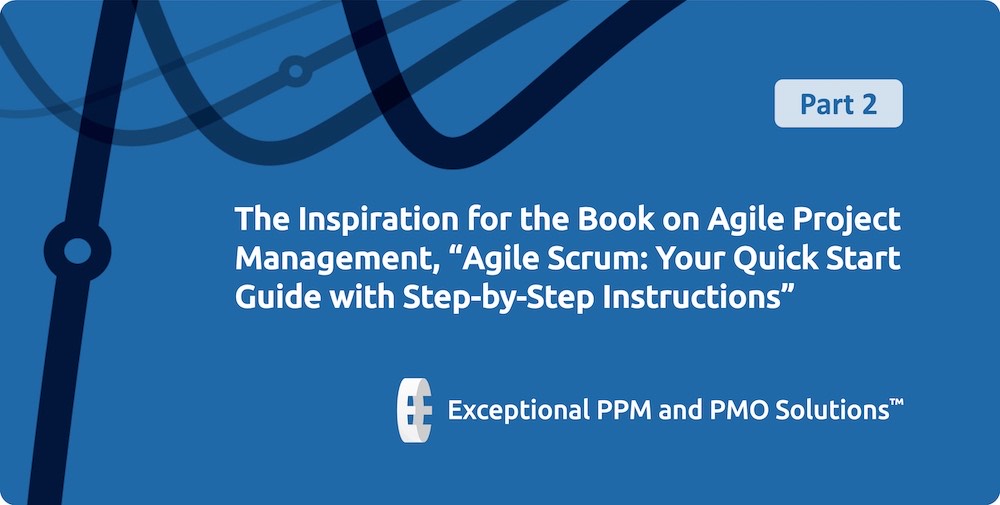
The Inspiration for the Book on Agile Project Management, Agile Scrum: Your Quick Start Guide with Step-by-Step Instructions
Scott M. Graffius, CEO of Exceptional PPM and PMO Solutions™, helps companies achieve their strategic objectives and business initiatives through project management leadership. A fantastic agile transformation outcome with a client organization in the entertainment industry was the inspiration for Scott's award-winning book, Agile Scrum: Your Quick Start Guide with Step-by-Step Instructions. This is the story behind the book—told by Scott. Identifying details have been changed and certain elements are not included.
This article is the second installment of the eight-part story. If you haven't already read the first post, you can find it here: Part 1: The Call.

Agile Transformation at an Entertainment Company | Part 2: The Goals

Highlights related to the goals follow.
The executive vice president (EVP) identified his top three desired outcomes:
- Accelerate the development and delivery of products and services—to be faster than the earlier baseline of 6-12 months,
- Improve the satisfaction of the Scrum Team—to be the same or better than it was earlier with the traditional/waterfall approach, and
- Improve the satisfaction of stakeholders—to also to be the same or better than it was earlier with the traditional/waterfall approach.
I individually met with and carefully listened to each member of the Scrum Team. There were recurring themes. We then met as a group and I asked them to identify their top two or three goals. They discussed the matter, voted, and decided on these:
- Meet or exceed the expectations of management, and
- Deliver valuable products.
I individually met with executives from different departments (the stakeholders). In every case, they related that things were OK with the earlier traditional/waterfall approach, but that things were worse now. The stakeholders indicated that, with the earlier approach, someone on the project team worked with their group to gather requirements, and around 6-12 months later the results were deployed. However, it was reported that with the then-current approach, the projects' purpose and requirements were not understood, and that what was produced was unusable. The goals of the stakeholders were:
- For them or their representatives to be as—or more—involved as earlier with the traditional/waterfall approach, and
- Get a usable product as often as—or more frequently than—earlier with the traditional/waterfall approach.
Here's a recap of everyone's goals. The EVP wants the development and delivery of products and services to be faster than 6-12 months, improved satisfaction of the Scrum Team, and improved satisfaction of stakeholders. The Scrum Team wants to meet or exceed expectations of management, and deliver valuable products. The stakeholders want (themselves or via their representatives) to be more involved in requirements/user stories and get useable project-delivered products more frequently than every 6-12 months.
Everyone permitted their goals to be shared with others. After discussing the subject with the EVP, I wrote the goals on oversize paper and posted it in a common area proximate to the Scrum Team and accessible to the stakeholders.
Highlights on the environment, roles, and practices—primarily focused on the Scrum Team—follow.
The Inspiration for the Book on Agile Project Management, Agile Scrum: Your Quick Start Guide with Step-by-Step Instructions continues with Part 3: The Environment.

About Agile Scrum: Your Quick Start Guide with Step-by-Step Instructions

A fantastic agile transformation experience and result with a client organization in the entertainment industry was the inspiration for Scott M. Graffius’s multi award-winning book, Agile Scrum: Your Quick Start Guide with Step-by-Step Instructions (ISBN-13: 978-1533370242).
Here's an excerpt from the book: "Shifting customer needs are common in today's marketplace. Businesses must be adaptive and responsive to change while delivering an exceptional customer experience to be competitive. Traditional development and delivery frameworks such as waterfall are often ineffective. In contrast, Scrum is a value-driven agile approach which incorporates adjustments based on regular and repeated customer and stakeholder feedback. And Scrum’s built-in rapid response to change leads to substantial benefits such as fast time-to-market, higher satisfaction, and continuous improvement—which supports innovation and drives competitive advantage."
With clear and easy to follow instructions, Agile Scrum: Your Quick Start Guide with Step-by-Step Instructions helps you:
- Implement and use the most popular agile framework―Scrum;
- Deliver products in short cycles with rapid adaptation to change, fast time-to-market, and continuous improvement; and
- Support innovation and drive competitive advantage.
Hailed by Literary Titan as “the book highlights the versatility of Scrum beautifully.”
Winner of 17 first place awards.
Agile Scrum: Your Quick Start Guide with Step-by-Step Instructions is available in paperback and ebook/Kindle in the United States and around the world. Some links by country follow. Get your copy today!
- 🇦🇺 Australia
- 🇦🇹 Austria
- 🇧🇪 Belgium
- 🇧🇷 Brazil
- 🇨🇦 Canada
- 🇨🇿 Czech Republic
- 🇩🇰 Denmark
- 🇫🇮 Finland
- 🇫🇷 France
- 🇩🇪 Germany
- 🇬🇷 Greece
- 🇭🇺 Hungary
- 🇮🇳 India
- 🇮🇪 Ireland
- 🇮🇱 Israel
- 🇮🇹 Italy
- 🇯🇵 Japan
- 🇱🇺 Luxembourg
- 🇲🇽 Mexico
- 🇳🇱 Netherlands
- 🇳🇿 New Zealand
- 🇳🇴 Norway
- 🇪🇸 Spain
- 🇸🇪 Sweden
- 🇨🇭 Switzerland
- 🇦🇪 UAE
- 🇬🇧 United Kingdom
- 🇺🇸 United States
- 🌏 More countries

Let's Connect

Connect with us on LinkedIn, Twitter, and Facebook.

© Copyright 2019 Scott M. Graffius, Exceptional PPM and PMO Solutions™. All rights reserved. This material may not be published, broadcast, rewritten or redistributed without the express written permission of Scott M. Graffius/Exceptional PPM and PMO Solutions™.

The Inspiration for the Book on Agile Project Management, “Agile Scrum: Your Quick Start Guide with Step-by-Step Instructions” | Part 3
19 March 2019

The Inspiration for the Book on Agile Project Management, Agile Scrum: Your Quick Start Guide with Step-by-Step Instructions
Scott M. Graffius, CEO of Exceptional PPM and PMO Solutions™, helps companies achieve their strategic objectives and business initiatives through project management leadership. A fantastic agile transformation outcome with a client organization in the entertainment industry was the inspiration for Scott's award-winning book, Agile Scrum: Your Quick Start Guide with Step-by-Step Instructions. This is the story behind the book—told by Scott. Identifying details have been changed and certain elements are not included.
This article is the third installment of the eight-part story. If you haven't already read the earlier parts, you can find them here:

Agile Transformation at an Entertainment Company | Part 3: The Environment

Highlights on the environment including roles and practices—primarily focused on the Scrum Team—follow.
I learned that the Scrum Team was composed of 16 people: one Scrum Master, one Product Owner, and 14 Development Team members. Both the Scrum Master and the Product Owner explained that they were familiar with agile, but that they had no prior work experience with agile/Scrum and no related training—except for what was provided by the value-added reseller (VAR). The Development Team consisted of 14 people: a technical architect, a UI designer, a business analyst, seven developers, three testers, and a technical writer. Eleven of the 14 members of the Development Team had no prior work experience with agile/Scrum and no related training—except for what was provided by the VAR. Of the 16 people on the Scrum Team, 15 were local (at an office in the greater Los Angeles area), and one—the Product Owner—was based out of her office in Paris, France.
Of the 16 people on the Scrum Team, two—the Scrum Master and the Product Owner—were full time on the project. All of the others were allocated about 50% on the project.
I was given a copy of the training binder left by the VAR. I was told that the contents—about 500 pages—reflected the totality of the training and reference material. The training session, led by the VAR, was attended by the Scrum Master and the all of the Development Team members. The executive vice president (EVP) attended portions. The Product Owner attended portions, listening by phone. The first page in the binder covered the Agile Manifesto, the second page was a two-column table which compared and contrasted waterfall and Scrum (e.g., waterfall freezes scope, Scrum freezes schedule), and the third page showed success rates of waterfall vs. Scrum (e.g., 29% of waterfall projects fail vs. 9% of agile projects). The remaining pages provided information about the VAR company and detailed instructions on how to use their software product. That constituted the training.
The Product Owner, Scrum Master, and Development Team reported that they followed the training and instructions provided by the VAR. I won't delineate the then-current roles further or describe all of the events and artifacts. However, some examples follow.
The Product Owner created a product vision statement and stored it in the software, but nobody else remembered seeing it.
The Product Owner created a product backlog in the software, but nobody else claimed to have seen it.
The Scrum Master facilitated a Sprint Planning event where the Development Team estimated work in terms of complexity, and the results were recorded in the software tool. It was reported that—due to the time difference—the Product Owner did not attend Sprint Planning meetings.
It was communicated that during Sprint execution, the Scrum Master would ask the Development Team if they had any notable progress; and only if the answer was yes, there was a Daily Scrum. As a result, the Daily Scrum event occurred around once or twice a week. When the meeting took place, the Scrum Master did a quick interview with each member of the Development Team and noted the results in the software tool.
I was told that the team followed the recommendation of the VAR for the sprint duration of four weeks.
The Sprint Reviews were attended by the Scrum Master, the Product Owner (remotely), all of the Development Team members, and the EVP. However, the other stakeholders did not attend the events. On average, about half of the work planned and committed to the sprint was "done." Both "done" and not-"done" items were demonstrated at the Sprint Review.
The Scrum Master reported that the team did conduct a Retrospective event at the end of each sprint and that the results were saved in the software tool. When I reviewed the information, I saw comments such as "we worked very hard" under the what went well category. Everything under the "what didn't go so well/opportunities for improvements" category were ideas for enhancement requests for the software tool. I was informed that the VAR instructed staff to convert everything that didn't go well into a suggestion for a future general release of the software or a request for a custom enhancement of the software.
None of the work from any of the sprints was released.
The Inspiration for the Book on Agile Project Management, Agile Scrum: Your Quick Start Guide with Step-by-Step Instructions continues with Part 4: The Options.

About Agile Scrum: Your Quick Start Guide with Step-by-Step Instructions

A fantastic agile transformation experience and result with a client organization in the entertainment industry was the inspiration for Scott M. Graffius’s multi award-winning book, Agile Scrum: Your Quick Start Guide with Step-by-Step Instructions (ISBN-13: 978-1533370242).
Here's an excerpt from the book: "Shifting customer needs are common in today's marketplace. Businesses must be adaptive and responsive to change while delivering an exceptional customer experience to be competitive. Traditional development and delivery frameworks such as waterfall are often ineffective. In contrast, Scrum is a value-driven agile approach which incorporates adjustments based on regular and repeated customer and stakeholder feedback. And Scrum’s built-in rapid response to change leads to substantial benefits such as fast time-to-market, higher satisfaction, and continuous improvement—which supports innovation and drives competitive advantage."
With clear and easy to follow instructions, Agile Scrum: Your Quick Start Guide with Step-by-Step Instructions helps you:
- Implement and use the most popular agile framework―Scrum;
- Deliver products in short cycles with rapid adaptation to change, fast time-to-market, and continuous improvement; and
- Support innovation and drive competitive advantage.
Hailed by Literary Titan as “the book highlights the versatility of Scrum beautifully.”
Winner of 17 first place awards.
Agile Scrum: Your Quick Start Guide with Step-by-Step Instructions is available in paperback and ebook/Kindle in the United States and around the world. Some links by country follow. Get your copy today!
- 🇦🇺 Australia
- 🇦🇹 Austria
- 🇧🇪 Belgium
- 🇧🇷 Brazil
- 🇨🇦 Canada
- 🇨🇿 Czech Republic
- 🇩🇰 Denmark
- 🇫🇮 Finland
- 🇫🇷 France
- 🇩🇪 Germany
- 🇬🇷 Greece
- 🇭🇺 Hungary
- 🇮🇳 India
- 🇮🇪 Ireland
- 🇮🇱 Israel
- 🇮🇹 Italy
- 🇯🇵 Japan
- 🇱🇺 Luxembourg
- 🇲🇽 Mexico
- 🇳🇱 Netherlands
- 🇳🇿 New Zealand
- 🇳🇴 Norway
- 🇪🇸 Spain
- 🇸🇪 Sweden
- 🇨🇭 Switzerland
- 🇦🇪 UAE
- 🇬🇧 United Kingdom
- 🇺🇸 United States
- 🌏 More countries

Let's Connect

Connect with us on LinkedIn, Twitter, and Facebook.

© Copyright 2019 Scott M. Graffius, Exceptional PPM and PMO Solutions™. All rights reserved. This material may not be published, broadcast, rewritten or redistributed without the express written permission of Scott M. Graffius/Exceptional PPM and PMO Solutions™.

The Inspiration for the Book on Agile Project Management, “Agile Scrum: Your Quick Start Guide with Step-by-Step Instructions” | Part 4
26 March 2019
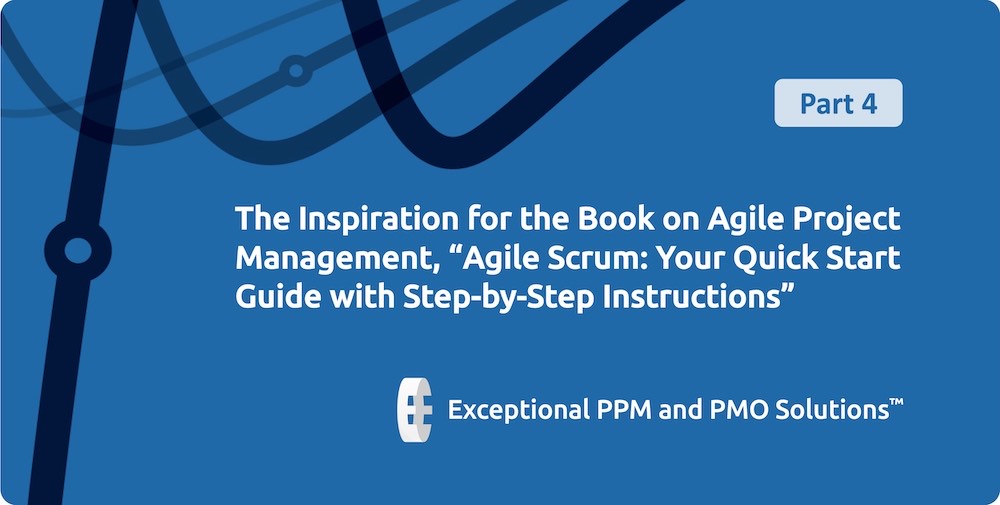
The Inspiration for the Book on Agile Project Management, Agile Scrum: Your Quick Start Guide with Step-by-Step Instructions
Scott M. Graffius, CEO of Exceptional PPM and PMO Solutions™, helps companies achieve their strategic objectives and business initiatives through project management leadership. A fantastic agile transformation outcome with a client organization in the entertainment industry was the inspiration for Scott's award-winning book, Agile Scrum: Your Quick Start Guide with Step-by-Step Instructions. This is the story behind the book—told by Scott. Identifying details have been changed and certain elements are not included.
This article is the fourth installment of the eight-part story. If you haven't already read the earlier parts, you can find them here:

Agile Transformation at an Entertainment Company | Part 4: The Options
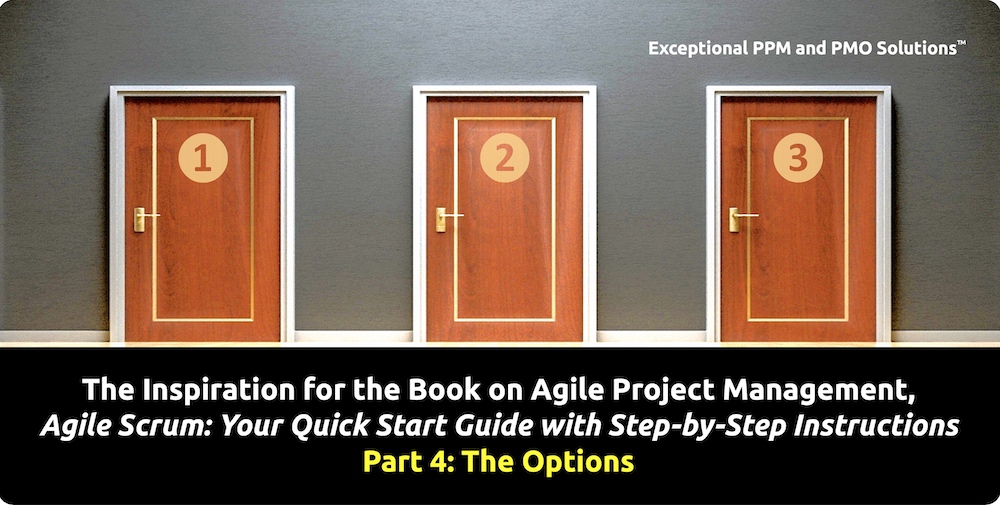
After gaining a broader and deeper understanding of the organization including their Scrum implementation, I met with the executive vice president (EVP) and we discussed next steps. I presented three options:
- No change,
- Revert to the earlier waterfall-only model, or
- "We can try different things" (aligned with the value of openness) with the objective of improving their agile implementation and achieving their goals.
I said, "we can try different things" because while I believed that changes would likely result in improvements, success could not be guaranteed. I also said, "we can try different things" because any meaningful change would require the cooperation and collaboration of many people. The EVP decided on the third option: trying different things.
The doing of "different things" started with training. I first met with the EVP. I then met with the Scrum Master in several one-on-one meetings. And since he was committed to education and improvement, he later on completed the Certified ScrumMaster (CSM) training and certification. The Product Owner was unable to attend the office in person for one-on-one training, but we communicated by phone and Skype. The EVP soon decided that the Product Owner needed to be co-located with the Scrum Team. He found a new Product Owner within the organization. I met with the new Product Owner in multiple one-on-one sessions. And—similar to what occurred with the Scrum Master—since the new Product Owner was committed to education and improvement, he subsequently completed the Certified Scrum Product Owner (CSPO) training and certification. I delivered training to the Development Team as a group. It included an overview and more in-depth coverage of certain topics such as pair programming and technical debt. Later on, some Development Team members completed the Certified Scrum Developer (CSD) training and certification. Stakeholder training follows next.
I delivered a one-hour overview of Scrum to the executive stakeholders in a group session. The attendees asked questions and made comments throughout the meeting. One stakeholder suggested that we do what the American Management Association says is best for Scrum. Then other attendees mentioned additional potential sources for information on agile. I explained that different organizations may have their own perspective on what works well for agile/Scrum, and that one way to go (I mentioned this in part to continue their engagement, involvement, and buy-in) is to look to the Scrum Alliance, a leading authority on the subject, but also see if others have ideas that are aligned with the authority and also fit the desired future state of the organization. I committed to doing the research and the stakeholders thanked me in advance.
I already had a library of 76 items on agile/Scrum—consisting of material from the Scrum Alliance, Project Management Institute, Deloitte Touche Tohmatsu, Gartner, KPMG, Harvard Business Review, IEEE, MIT, Forbes, and many others. I expanded it to include sources mentioned by stakeholders during the training session and I diligently reviewed all of the content. The diverse sources identified several values and practices as being central in successful Scrum implementations, and such factors were typically consistent with guidelines from the Scrum Alliance. I then met with each of the stakeholders individually and presented them with a summary of information from the Scrum Alliance and others.
I facilitated a follow-up group meeting with the executive stakeholders. Information from the one-hour training and the diverse sources was summarized. The stakeholders concluded that the central problem with the then-current implementation was that people were not following good practices. They then discussed, voted, and identified what they viewed as the high-level top 10 success factors for a Scrum implementation at the organization based on the previously presented information. In no particular order, the top 10 items were:
- Support from management;
- Each member of the Scrum Team (Scrum Master, Product Owner, and Development Team) is 100% allocated to the project;
- There is an agile coach, agile Project Management Office or agile Center of Excellence;
- Satisfaction is a crucial metric;
- The Scrum Team has no more than 11 people;
- The Scrum Team is co-located;
- There are consistent practices and processes;
- There is a digital wallboard or other information radiator;
- There are frequent and high-quality interactions; and
- There is continuous improvement/inspect and adapt.
Some of the items overlap/are not mutually exclusive, and the items are not exhaustive. I thanked the executive stakeholders for their support, and I told them that the 10 factors are built into the go-forward plan. The stakeholders expressed their appreciation.
The EVP and I conducted a mini-retrospective on the training sessions. The EVP was enthusiastic about what we've done so far, and he said that morale had improved. He authorized company-paid CSM, CSPO, and CSD trainings and certifications for staff (mentioned earlier). The EVP said we could advance to the next stage: piloting changes. I asked if he was open to terminating the use of the software tool introduced by the value-added reseller (VAR). He initially said that so much time and money had been invested in it that it would be hard to justify doing so. I said it differently: "We can try different things" could mean putting the software tool on vacation for a period. He agreed. We moved to the pilot—which involved doing many things differently. Examples follow.
The Inspiration for the Book on Agile Project Management, Agile Scrum: Your Quick Start Guide with Step-by-Step Instructions continues with Part 5: The Pilot — Vision, Roadmap and Release Plan, and Product Backlog.

About Agile Scrum: Your Quick Start Guide with Step-by-Step Instructions

A fantastic agile transformation experience and result with a client organization in the entertainment industry was the inspiration for Scott M. Graffius’s multi award-winning book, Agile Scrum: Your Quick Start Guide with Step-by-Step Instructions (ISBN-13: 978-1533370242).
Here's an excerpt from the book: "Shifting customer needs are common in today's marketplace. Businesses must be adaptive and responsive to change while delivering an exceptional customer experience to be competitive. Traditional development and delivery frameworks such as waterfall are often ineffective. In contrast, Scrum is a value-driven agile approach which incorporates adjustments based on regular and repeated customer and stakeholder feedback. And Scrum’s built-in rapid response to change leads to substantial benefits such as fast time-to-market, higher satisfaction, and continuous improvement—which supports innovation and drives competitive advantage."
With clear and easy to follow instructions, Agile Scrum: Your Quick Start Guide with Step-by-Step Instructions helps you:
- Implement and use the most popular agile framework―Scrum;
- Deliver products in short cycles with rapid adaptation to change, fast time-to-market, and continuous improvement; and
- Support innovation and drive competitive advantage.
Hailed by Literary Titan as “the book highlights the versatility of Scrum beautifully.”
Winner of 17 first place awards.
Agile Scrum: Your Quick Start Guide with Step-by-Step Instructions is available in paperback and ebook/Kindle in the United States and around the world. Some links by country follow. Get your copy today!
- 🇦🇺 Australia
- 🇦🇹 Austria
- 🇧🇪 Belgium
- 🇧🇷 Brazil
- 🇨🇦 Canada
- 🇨🇿 Czech Republic
- 🇩🇰 Denmark
- 🇫🇮 Finland
- 🇫🇷 France
- 🇩🇪 Germany
- 🇬🇷 Greece
- 🇭🇺 Hungary
- 🇮🇳 India
- 🇮🇪 Ireland
- 🇮🇱 Israel
- 🇮🇹 Italy
- 🇯🇵 Japan
- 🇱🇺 Luxembourg
- 🇲🇽 Mexico
- 🇳🇱 Netherlands
- 🇳🇿 New Zealand
- 🇳🇴 Norway
- 🇪🇸 Spain
- 🇸🇪 Sweden
- 🇨🇭 Switzerland
- 🇦🇪 UAE
- 🇬🇧 United Kingdom
- 🇺🇸 United States
- 🌏 More countries

Let's Connect

Connect with us on LinkedIn, Twitter, and Facebook.

© Copyright 2019 Scott M. Graffius, Exceptional PPM and PMO Solutions™. All rights reserved. This material may not be published, broadcast, rewritten or redistributed without the express written permission of Scott M. Graffius/Exceptional PPM and PMO Solutions™.

The Inspiration for the Book on Agile Project Management, “Agile Scrum: Your Quick Start Guide with Step-by-Step Instructions” | Part 5
31 March 2019

The Inspiration for the Book on Agile Project Management, Agile Scrum: Your Quick Start Guide with Step-by-Step Instructions
Scott M. Graffius, CEO of Exceptional PPM and PMO Solutions™, helps companies achieve their strategic objectives and business initiatives through project management leadership. A fantastic agile transformation outcome with a client organization in the entertainment industry was the inspiration for Scott's award-winning book, Agile Scrum: Your Quick Start Guide with Step-by-Step Instructions. This is the story behind the book—told by Scott. Identifying details have been changed and certain elements are not included.
This article is the fifth installment of the eight-part story. If you haven't already read the earlier parts, you can find them here:

Agile Transformation at an Entertainment Company | Part 5: The Pilot — Vision, Roadmap and Release Plan, and Product Backlog
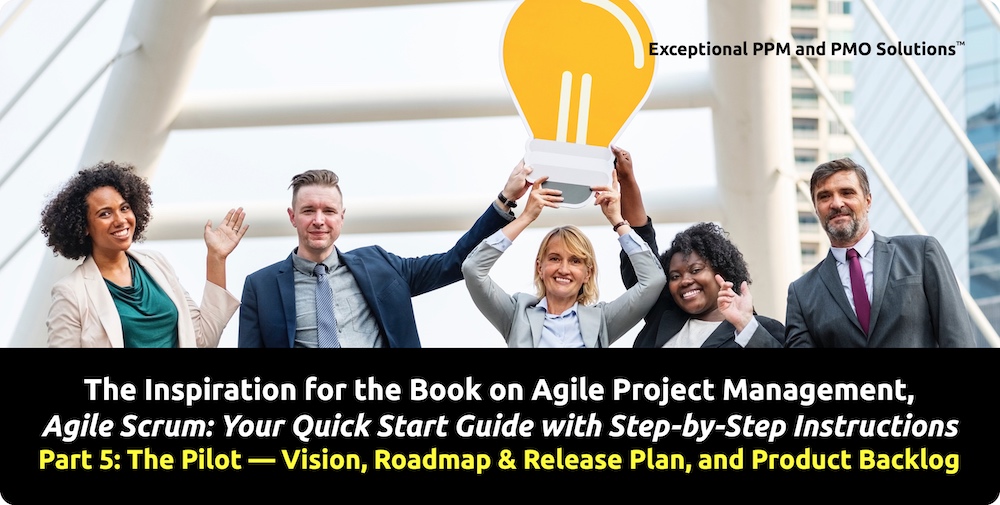
We advanced to the pilot—which included doing many things differently. Examples follow.
The Product Owner and I discussed techniques on developing a product vision statement. He opted to use the template attributed to Geoffrey Moore. The Product Owner created a draft of the vision and sent it with a request for feedback to the stakeholders. After receiving feedback, the Product Owner revised and finalized the product vision. He wrote the statement on oversize paper and posted it in a prominent location where the Scrum Team (Scrum Master, Product Owner, and Development Team) and stakeholders could easily see it.
The Product Owner and I then discussed techniques on creating and maintaining a product roadmap/release plan. He opted for a simple table with four rows and four columns. The rows included:
- Name (the title of the product or major release),
- Goal (the reason for creating it),
- Features (a high-level list of features), and
- Estimated number of sprints.
For the columns, there was one for each quarter of the year. Similar to what was done with the product vision, the Product Owner sent the plan with a request for feedback to the stakeholders. After receiving feedback, the Product Owner revised and the plan, wrote it on oversize paper, and posted it next to the product vision statement.
Aspects of team formation were covered already. The new Scrum team totaled 11 people. All were co-located and 100% allocated to the project.
The Product Owner and I discussed techniques on developing and maintaining the product backlog. He opted to employ a simple table format with six columns:
- ID#,
- User story/description,
- Category (he decided on four types: feature, bug, technical debt, and other),
- Story point estimate for complexity,
- Priority based on business value, and
- Status.
To help with user stories, the Product Owner often referenced the INVEST (Independent, Negotiable, Valuable, Estimable, Small, and Testable) model developed by Bill Wake. For priority, the Product Owner initially used the MoSCoW method (Must have, Should have, Could have, or Won't have). Later, the Product Owner found the business value/risk method (where each item is rated as high or low in two dimensions—business value and risk, ...) to be the most beneficial, and the Product Owner continues to use that approach today. In a session facilitated by the Scrum Master, the Product Owner presented the user stories to the Development Team, and participants provided story points (using physical cards for the exercise) for estimates of complexity of each item. Later, the team tried t-shirt sizing (S, M, L, and XL designations) for estimates of complexity, but they decided to return to story points.
Previously, sprints were four weeks in length. Now the team was using the shorter duration of two weeks. A key benefit was that the Scrum value of focus was improved.
The Inspiration for the Book on Agile Project Management, Agile Scrum: Your Quick Start Guide with Step-by-Step Instructions continues with Part 6: The Pilot — Sprint Planning and Sprint Execution.

About Agile Scrum: Your Quick Start Guide with Step-by-Step Instructions

A fantastic agile transformation experience and result with a client organization in the entertainment industry was the inspiration for Scott M. Graffius’s multi award-winning book, Agile Scrum: Your Quick Start Guide with Step-by-Step Instructions (ISBN-13: 978-1533370242).
Here's an excerpt from the book: "Shifting customer needs are common in today's marketplace. Businesses must be adaptive and responsive to change while delivering an exceptional customer experience to be competitive. Traditional development and delivery frameworks such as waterfall are often ineffective. In contrast, Scrum is a value-driven agile approach which incorporates adjustments based on regular and repeated customer and stakeholder feedback. And Scrum’s built-in rapid response to change leads to substantial benefits such as fast time-to-market, higher satisfaction, and continuous improvement—which supports innovation and drives competitive advantage."
With clear and easy to follow instructions, Agile Scrum: Your Quick Start Guide with Step-by-Step Instructions helps you:
- Implement and use the most popular agile framework―Scrum;
- Deliver products in short cycles with rapid adaptation to change, fast time-to-market, and continuous improvement; and
- Support innovation and drive competitive advantage.
Hailed by Literary Titan as “the book highlights the versatility of Scrum beautifully.”
Winner of 17 first place awards.
Agile Scrum: Your Quick Start Guide with Step-by-Step Instructions is available in paperback and ebook/Kindle in the United States and around the world. Some links by country follow. Get your copy today!
- 🇦🇺 Australia
- 🇦🇹 Austria
- 🇧🇪 Belgium
- 🇧🇷 Brazil
- 🇨🇦 Canada
- 🇨🇿 Czech Republic
- 🇩🇰 Denmark
- 🇫🇮 Finland
- 🇫🇷 France
- 🇩🇪 Germany
- 🇬🇷 Greece
- 🇭🇺 Hungary
- 🇮🇳 India
- 🇮🇪 Ireland
- 🇮🇱 Israel
- 🇮🇹 Italy
- 🇯🇵 Japan
- 🇱🇺 Luxembourg
- 🇲🇽 Mexico
- 🇳🇱 Netherlands
- 🇳🇿 New Zealand
- 🇳🇴 Norway
- 🇪🇸 Spain
- 🇸🇪 Sweden
- 🇨🇭 Switzerland
- 🇦🇪 UAE
- 🇬🇧 United Kingdom
- 🇺🇸 United States
- 🌏 More countries

Let's Connect

Connect with us on LinkedIn, Twitter, and Facebook.

© Copyright 2019 Scott M. Graffius, Exceptional PPM and PMO Solutions™. All rights reserved. This material may not be published, broadcast, rewritten or redistributed without the express written permission of Scott M. Graffius/Exceptional PPM and PMO Solutions™.

The Inspiration for the Book on Agile Project Management, “Agile Scrum: Your Quick Start Guide with Step-by-Step Instructions” | Part 6
04 April 2019
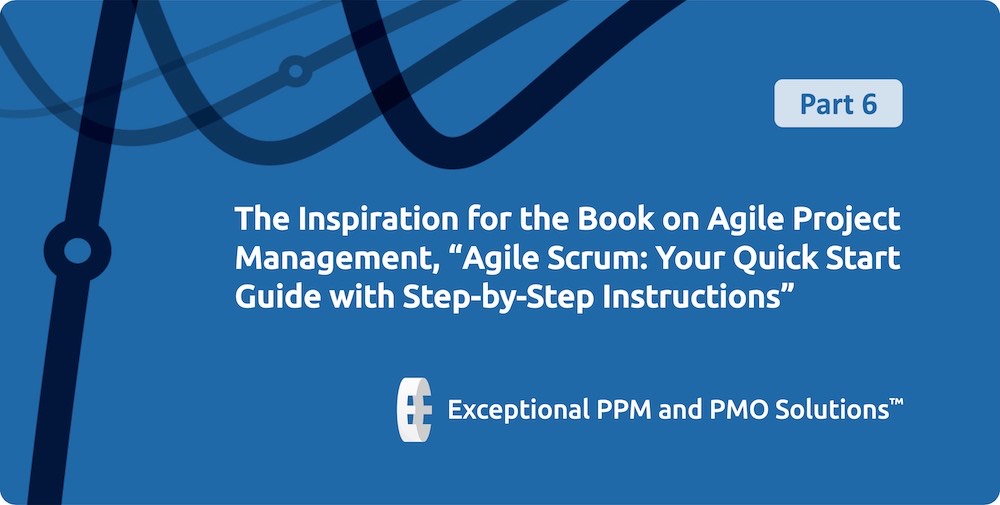
The Inspiration for the Book on Agile Project Management, Agile Scrum: Your Quick Start Guide with Step-by-Step Instructions
Scott M. Graffius, CEO of Exceptional PPM and PMO Solutions™, helps companies achieve their strategic objectives and business initiatives through project management leadership. A fantastic agile transformation outcome with a client organization in the entertainment industry was the inspiration for Scott's award-winning book, Agile Scrum: Your Quick Start Guide with Step-by-Step Instructions. This is the story behind the book—told by Scott. Identifying details have been changed and certain elements are not included.
This article is the sixth installment of the eight-part story. If you haven't already read the earlier parts, you can find them here:
- Part 1: The Call;
- Part 2: The Goals;
- Part 3: The Environment;
- Part 4: The Options; and
- Part 5: The Pilot – Vision, Roadmap and Release Plan, and Product Backlog.

Agile Transformation at an Entertainment Company | Part 6: The Pilot — Sprint Planning and Sprint Execution

The Product Owner, Scrum Master and I discussed sprint planning techniques. The Scrum Master decided that the meeting event would be handled via two separate sessions—part 1 (what will be committed to for the upcoming sprint) and part 2 (how to accomplish the work identified in part 1).
For sprint planning part 1, the timebox (not to exceed duration) for the meeting was calculated as:
- 2
- multiplied by the number of weeks in the upcoming sprint (2 in this case),
- which equaled 4 hours for the event.
The Scrum Master made the following information visible during the event: start and end dates for the sprint, (after a sprint was completed) the results of the last sprint review event, and (after a sprint was completed) the results from the last sprint retrospective event. The Product Owner reminded the Development Team about the product vision statement, and the Product Owner shared the sprint goal (such as "implement shopping cart functionality ..."). The Development Team determined their capacity in work hours for the upcoming sprint. It was calculated as:
- the number of people in the Development Team
- multiplied by the number of project productive hours (which excluded time outside the sprint such as company meetings, trainings, vacation time, etc.) per workday
- multiplied by number of workdays in the sprint.
(Estimation via story points, and prioritization by the Product Owner were already taken care of.)
For each item in the product backlog, participants discussed the user stories/requirements including acceptance criteria, assumptions, dependencies, risks, and anything else requiring a conversation to get a good understanding of the item. The Development Team then committed to the entries which they thought could be completed in the upcoming sprint. The technique they employed involved asking "Can we do this first item in the product backlog?" If the answer was yes, they selected it and proceeded to the next item and continued until the team believed that no more work could be done in the sprint. After the Development Team had worked together and had data on actual velocity (the number of story points completed in a sprint), they also considered that historical metric—comparing it with story points for items in the sprint. The Product Owner updated the product backlog, identifying the items committed by the Development Team to be done for the upcoming sprint.
For sprint planning part 2, the timebox for the meeting was calculated as:
- 2
- multiplied by the number of weeks in the upcoming sprint (2 in this case),
- which equaled 4 hours for the event.
The Scrum team created the sprint backlog. It had the following columns:
- ID#,
- Description,
- Story points,
- Task information (meetings, designs, coding, code review, testing, etc.),
- Estimation in hours (they adopted the practice that if effort is greater than eight hours, split the task into smaller ones),
- Owner (where members of the Development Team self-assign tasks),
- Status, and
- Hours of work remaining.
During the meeting, the Scrum team compared the total estimated work hours for the sprint with the Development Team’s capacity (mentioned under the part 1 meeting) for the sprint. If the Development Team believed that the sprint backlog contained too much work to be done during the sprint, they collaborated with the Product Owner to remove one or more items. If the Development Team believed they could handle more work during the sprint, they worked with the Product Owner to move one or more of the high priority items from the product backlog to the sprint backlog.
The Product Owner, Scrum Master and I discussed sprint execution. Select examples of what was decided and done are highlighted next.
The Development Team set up a task board (also known as a Scrum board) to reflect the work in the current iteration. They went with a simple format. The board depicted work in rows and columns where rows included work items, and columns reflected status (To Do, Doing, and Done). Work was addressed from top (highest priority) to bottom, and work migrated from left to right on the task board as it progressed. The task board is also covered in the daily Scrum meeting.
The Scrum Master decided to use a sprint burndown chart to track and communicate progress during the sprint. He set it up and updated it each workday, usually immediately after the daily Scrum meeting.
The Scrum Master created an impediment backlog to capture things preventing the team from progressing or improving. This backlog was updated daily, typically immediately after the daily Scrum meeting.
At the daily Scrum meeting event, the Development Team shared status, plans, and any impediments. Before this pilot with changes, the team was not conducting the daily Scrum (or updating the task board, burndown chart, and impediments backlog) consistently. Under the pilot (and subsequently), the Development Team met for up to 15 minutes (timebox) each workday, and it was conducted at the same time (10:00 a.m.) each day. At this daily stand-up session, the Development Team and the Scrum Master met where the task board, sprint burndown chart, and impediment backlog were posted. Each Development Team member described what he/she worked on since the last Scrum meeting, and he/she updated the task board. Next, the same Development Team member explained what he/she would work on that day, and he/she updated the task board. Lastly, the same Development Team member reported any impediments. (The Scrum Master recorded any issues in the impediments backlog. If a discussion was required, it took place immediately after the daily Scrum. The Scrum Master helped resolve impediments.) The steps were repeated for other members of the Development Team.
The Scrum Team built an increment of functionality during every sprint, and the increment was potentially shippable because the Product Owner might decide for it to be implemented at the end of the sprint. Said differently, potentially shippable is defined by a state of confidence or readiness, and shipping is a business decision. Commencing with the pilot, the organization started releasing products as often as every sprint (two weeks).
The Inspiration for the Book on Agile Project Management, Agile Scrum: Your Quick Start Guide with Step-by-Step Instructions continues with Part 7: The Pilot — Sprint Review and Sprint Retrospective.

About Agile Scrum: Your Quick Start Guide with Step-by-Step Instructions

A fantastic agile transformation experience and result with a client organization in the entertainment industry was the inspiration for Scott M. Graffius’s multi award-winning book, Agile Scrum: Your Quick Start Guide with Step-by-Step Instructions (ISBN-13: 978-1533370242).
Here's an excerpt from the book: "Shifting customer needs are common in today's marketplace. Businesses must be adaptive and responsive to change while delivering an exceptional customer experience to be competitive. Traditional development and delivery frameworks such as waterfall are often ineffective. In contrast, Scrum is a value-driven agile approach which incorporates adjustments based on regular and repeated customer and stakeholder feedback. And Scrum’s built-in rapid response to change leads to substantial benefits such as fast time-to-market, higher satisfaction, and continuous improvement—which supports innovation and drives competitive advantage."
With clear and easy to follow instructions, Agile Scrum: Your Quick Start Guide with Step-by-Step Instructions helps you:
- Implement and use the most popular agile framework―Scrum;
- Deliver products in short cycles with rapid adaptation to change, fast time-to-market, and continuous improvement; and
- Support innovation and drive competitive advantage.
Hailed by Literary Titan as “the book highlights the versatility of Scrum beautifully.”
Winner of 17 first place awards.
Agile Scrum: Your Quick Start Guide with Step-by-Step Instructions is available in paperback and ebook/Kindle in the United States and around the world. Some links by country follow. Get your copy today!
- 🇦🇺 Australia
- 🇦🇹 Austria
- 🇧🇪 Belgium
- 🇧🇷 Brazil
- 🇨🇦 Canada
- 🇨🇿 Czech Republic
- 🇩🇰 Denmark
- 🇫🇮 Finland
- 🇫🇷 France
- 🇩🇪 Germany
- 🇬🇷 Greece
- 🇭🇺 Hungary
- 🇮🇳 India
- 🇮🇪 Ireland
- 🇮🇱 Israel
- 🇮🇹 Italy
- 🇯🇵 Japan
- 🇱🇺 Luxembourg
- 🇲🇽 Mexico
- 🇳🇱 Netherlands
- 🇳🇿 New Zealand
- 🇳🇴 Norway
- 🇪🇸 Spain
- 🇸🇪 Sweden
- 🇨🇭 Switzerland
- 🇦🇪 UAE
- 🇬🇧 United Kingdom
- 🇺🇸 United States
- 🌏 More countries

Let's Connect

Connect with us on LinkedIn, Twitter, and Facebook.

© Copyright 2019 Scott M. Graffius, Exceptional PPM and PMO Solutions™. All rights reserved. This material may not be published, broadcast, rewritten or redistributed without the express written permission of Scott M. Graffius/Exceptional PPM and PMO Solutions™.

The Inspiration for the Book on Agile Project Management, “Agile Scrum: Your Quick Start Guide with Step-by-Step Instructions” | Part 7
09 April 2019
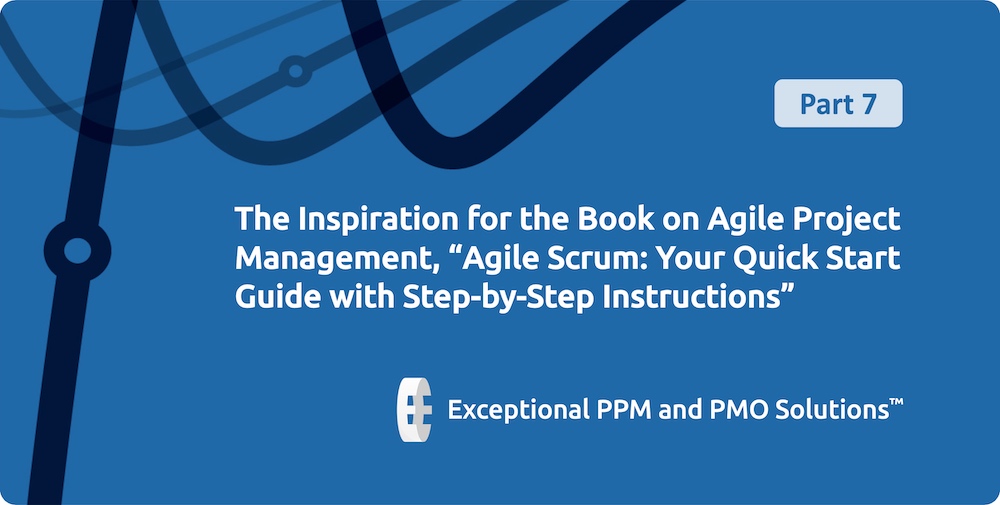
The Inspiration for the Book on Agile Project Management, Agile Scrum: Your Quick Start Guide with Step-by-Step Instructions
Scott M. Graffius, CEO of Exceptional PPM and PMO Solutions™, helps companies achieve their strategic objectives and business initiatives through project management leadership. A fantastic agile transformation outcome with a client organization in the entertainment industry was the inspiration for Scott's award-winning book, Agile Scrum: Your Quick Start Guide with Step-by-Step Instructions. This is the story behind the book—told by Scott. Identifying details have been changed and certain elements are not included.
This article is the seventh installment of the eight-part story. If you haven't already read the earlier parts, you can find them here:
- Part 1: The Call;
- Part 2: The Goals;
- Part 3: The Environment;
- Part 4: The Options;
- Part 5: The Pilot — Vision, Roadmap and Release Plan, and Product Backlog; and
- Part 6: The Pilot — Sprint Planning and Sprint Execution.

Agile Transformation at an Entertainment Company | Part 7: The Pilot — Sprint Review and Sprint Retrospective
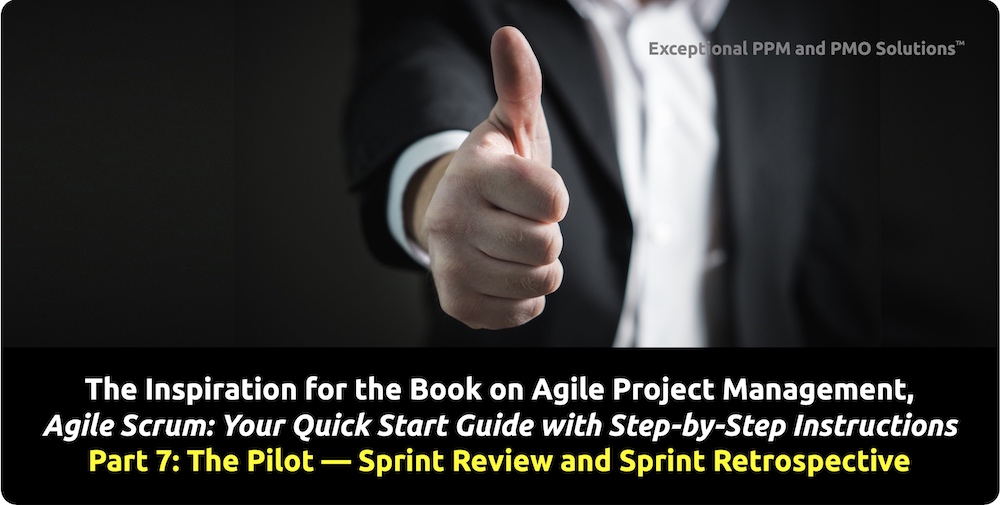
The Scrum team—Product Owner, Scrum Master, and the Development Team—and I discussed techniques for the sprint review. The event is sometimes referred to as the sprint demo. The timebox (not to exceed duration) in hours for the meeting was calculated as:
- 1
- multiplied by the number of weeks in the upcoming sprint (2 in this case),
- which equaled 2 hours for the event.
Participants included the Product Owner, Scrum Master, Development Team, and stakeholders. All of the stakeholders (the executives mentioned in earlier parts of the story) were invited to and attended the sprint review. At the session, the Product Owner welcomed attendees and communicated the agenda. He pointed out the sprint goal, which was displayed on the wall in the meeting room. Next, the Development Team listed the work that was committed to the sprint. They then listed the work that was completed and the work that was not completed. For each completed story/feature, the Development Team demonstrated the "done" working functionality and answered questions. Stakeholders were invited to interact with the "done" working functionality and they did so. Then the entire group reviewed the product backlog and collaborated on what to do next. The Product Owner incorporated feedback into the Product Backlog. It involved adding new items to the backlog and/or re-prioritizing existing items. After the sprint review, the Scrum Master incorporated any feedback related to problems into the impediments backlog.
The Scrum Master and I discussed techniques for the sprint retrospective event. The timebox in hours for the meeting was calculated as:
- 0.75
- multiplied by the number of weeks in the upcoming sprint (2 in this case),
- which equaled 1.50 hours for the event.
At the sprint retrospective, the Development Team identified what went well, what didn't go well, and improvements to be implemented in the upcoming sprint—an example of inspection and adaptation. For improvements to be implemented, each member of the Development Team wrote their top one, two or three suggestions on sticky notes. Each idea got its own sticky note. Then the Development Team grouped the sticky notes into categories/themes, and they discussed the items and voted to determine the top one (initially limited to one, later it was raised to two) for adaptation and improvement. The Development Team committed to the change and the Scrum Master recorded the information.
The Inspiration for the Book on Agile Project Management, Agile Scrum: Your Quick Start Guide with Step-by-Step Instructions concludes with Part 8: The Success.

About Agile Scrum: Your Quick Start Guide with Step-by-Step Instructions

A fantastic agile transformation experience and result with a client organization in the entertainment industry was the inspiration for Scott M. Graffius’s multi award-winning book, Agile Scrum: Your Quick Start Guide with Step-by-Step Instructions (ISBN-13: 978-1533370242).
Here's an excerpt from the book: "Shifting customer needs are common in today's marketplace. Businesses must be adaptive and responsive to change while delivering an exceptional customer experience to be competitive. Traditional development and delivery frameworks such as waterfall are often ineffective. In contrast, Scrum is a value-driven agile approach which incorporates adjustments based on regular and repeated customer and stakeholder feedback. And Scrum’s built-in rapid response to change leads to substantial benefits such as fast time-to-market, higher satisfaction, and continuous improvement—which supports innovation and drives competitive advantage."
With clear and easy to follow instructions, Agile Scrum: Your Quick Start Guide with Step-by-Step Instructions helps you:
- Implement and use the most popular agile framework―Scrum;
- Deliver products in short cycles with rapid adaptation to change, fast time-to-market, and continuous improvement; and
- Support innovation and drive competitive advantage.
Hailed by Literary Titan as “the book highlights the versatility of Scrum beautifully.”
Winner of 17 first place awards.
Agile Scrum: Your Quick Start Guide with Step-by-Step Instructions is available in paperback and ebook/Kindle in the United States and around the world. Some links by country follow. Get your copy today!
- 🇦🇺 Australia
- 🇦🇹 Austria
- 🇧🇪 Belgium
- 🇧🇷 Brazil
- 🇨🇦 Canada
- 🇨🇿 Czech Republic
- 🇩🇰 Denmark
- 🇫🇮 Finland
- 🇫🇷 France
- 🇩🇪 Germany
- 🇬🇷 Greece
- 🇭🇺 Hungary
- 🇮🇳 India
- 🇮🇪 Ireland
- 🇮🇱 Israel
- 🇮🇹 Italy
- 🇯🇵 Japan
- 🇱🇺 Luxembourg
- 🇲🇽 Mexico
- 🇳🇱 Netherlands
- 🇳🇿 New Zealand
- 🇳🇴 Norway
- 🇪🇸 Spain
- 🇸🇪 Sweden
- 🇨🇭 Switzerland
- 🇦🇪 UAE
- 🇬🇧 United Kingdom
- 🇺🇸 United States
- 🌏 More countries

Let's Connect

Connect with us on LinkedIn, Twitter, and Facebook.

© Copyright 2019 Scott M. Graffius, Exceptional PPM and PMO Solutions™. All rights reserved. This material may not be published, broadcast, rewritten or redistributed without the express written permission of Scott M. Graffius/Exceptional PPM and PMO Solutions™.

The Inspiration for the Book on Agile Project Management, “Agile Scrum: Your Quick Start Guide with Step-by-Step Instructions” | Part 8
14 April 2019

The Inspiration for the Book on Agile Project Management, Agile Scrum: Your Quick Start Guide with Step-by-Step Instructions
Scott M. Graffius, CEO of Exceptional PPM and PMO Solutions™, helps companies achieve their strategic objectives and business initiatives through project management leadership. A fantastic agile transformation outcome with a client organization in the entertainment industry was the inspiration for Scott's award-winning book, Agile Scrum: Your Quick Start Guide with Step-by-Step Instructions. This is the story behind the book—told by Scott. Identifying details have been changed and certain elements are not included.
This article is the final installment of the eight-part story. If you haven't already read the earlier parts, you can find them here:
- Part 1: The Call;
- Part 2: The Goals;
- Part 3: The Environment;
- Part 4: The Options;
- Part 5: The Pilot — Vision, Roadmap and Release Plan, and Product Backlog;
- Part 6: The Pilot — Sprint Planning and Sprint Execution; and
- Part 7: The Pilot — Sprint Review and Sprint Retrospective.

Agile Transformation at an Entertainment Company | Part 8: The Success
By adopting an agile mindset and providing improved engagement, collaboration, transparency, and adaptability via Scrum's values, roles, events, and artifacts, the results were excellent. After one sprint, satisfaction ratings for the Development Team and stakeholders were higher than the target. After three sprints, the output of the Scrum Team became consistent and predictable, satisfaction increased even further, and all of the seven goals mentioned earlier were achieved. Here's an overview:
🎯 Goal 1
- Source: This goal was identified by the EVP (executive vice president)
- Desired outcome: Develop and deliver products and services faster than 6-12 months
- Result: The goal was achieved (with the agile transformation, delivery occurred as often as every two weeks)
🎯 Goal 2
- Source: This goal was identified by the EVP
- Desired outcome: Improve the satisfaction of the Scrum Team
- Result: The goal was achieved
🎯 Goal 3
- Source: This goal was identified by the EVP
- Desired outcome: Improve the satisfaction of the stakeholders
- Result: The goal was achieved
🎯 Goal 4
- Source: This goal was identified by the Scrum Team (Scrum Master, Product Owner, and the Development Team)
- Desired outcome: Meet or exceed the expectations of management
- Result: The goal was achieved
🎯 Goal 5
- Source: This goal was identified by the Scrum Team
- Desired outcome: Deliver valuable products/services
- Result: The goal was achieved
🎯 Goal 6
- Source: This goal was identified by the stakeholders
- Desired outcome: For stakeholders or their representatives to be more involved in requirements
- Result: The goal was achieved
🎯 Goal 7
- Source: This goal was identified by the stakeholders
- Desired outcome: Get useable products delivered more frequently than 6-12 months
- Result: The goal was achieved (with the agile transformation, delivery occurred as often as every two weeks)
The EVP, Scrum Team, and stakeholders declared the pilot a success and they made this implementation of Scrum the preferred approach for the development and delivery of products and services going forward.
In addition to achieving the goals summarized above, the agile transformation also supported the organization's efforts to innovate and drive their competitive advantage. It became more successful. As the business grew, so has the number of Scrum teams. Originally numbering one, the division presently has six Scrum teams.
This concludes The Inspiration for the Book on Agile Project Management, Agile Scrum: Your Quick Start Guide with Step-by-Step Instructions.

About Agile Scrum: Your Quick Start Guide with Step-by-Step Instructions

A fantastic agile transformation experience and result with a client organization in the entertainment industry was the inspiration for Scott M. Graffius’s multi award-winning book, Agile Scrum: Your Quick Start Guide with Step-by-Step Instructions (ISBN-13: 978-1533370242).
Here's an excerpt from the book: "Shifting customer needs are common in today's marketplace. Businesses must be adaptive and responsive to change while delivering an exceptional customer experience to be competitive. Traditional development and delivery frameworks such as waterfall are often ineffective. In contrast, Scrum is a value-driven agile approach which incorporates adjustments based on regular and repeated customer and stakeholder feedback. And Scrum’s built-in rapid response to change leads to substantial benefits such as fast time-to-market, higher satisfaction, and continuous improvement—which supports innovation and drives competitive advantage."
With clear and easy to follow instructions, Agile Scrum: Your Quick Start Guide with Step-by-Step Instructions helps you:
- Implement and use the most popular agile framework―Scrum;
- Deliver products in short cycles with rapid adaptation to change, fast time-to-market, and continuous improvement; and
- Support innovation and drive competitive advantage.
Hailed by Literary Titan as “the book highlights the versatility of Scrum beautifully.”
Winner of 17 first place awards.
Agile Scrum: Your Quick Start Guide with Step-by-Step Instructions is available in paperback and ebook/Kindle in the United States and around the world. Some links by country follow. Get your copy today!
- 🇦🇺 Australia
- 🇦🇹 Austria
- 🇧🇪 Belgium
- 🇧🇷 Brazil
- 🇨🇦 Canada
- 🇨🇿 Czech Republic
- 🇩🇰 Denmark
- 🇫🇮 Finland
- 🇫🇷 France
- 🇩🇪 Germany
- 🇬🇷 Greece
- 🇭🇺 Hungary
- 🇮🇳 India
- 🇮🇪 Ireland
- 🇮🇱 Israel
- 🇮🇹 Italy
- 🇯🇵 Japan
- 🇱🇺 Luxembourg
- 🇲🇽 Mexico
- 🇳🇱 Netherlands
- 🇳🇿 New Zealand
- 🇳🇴 Norway
- 🇪🇸 Spain
- 🇸🇪 Sweden
- 🇨🇭 Switzerland
- 🇦🇪 UAE
- 🇬🇧 United Kingdom
- 🇺🇸 United States
- 🌏 More countries

Let's Connect

Connect with us on LinkedIn, Twitter, and Facebook.

© Copyright 2019 Scott M. Graffius, Exceptional PPM and PMO Solutions™. All rights reserved. This material may not be published, broadcast, rewritten or redistributed without the express written permission of Scott M. Graffius/Exceptional PPM and PMO Solutions™.
